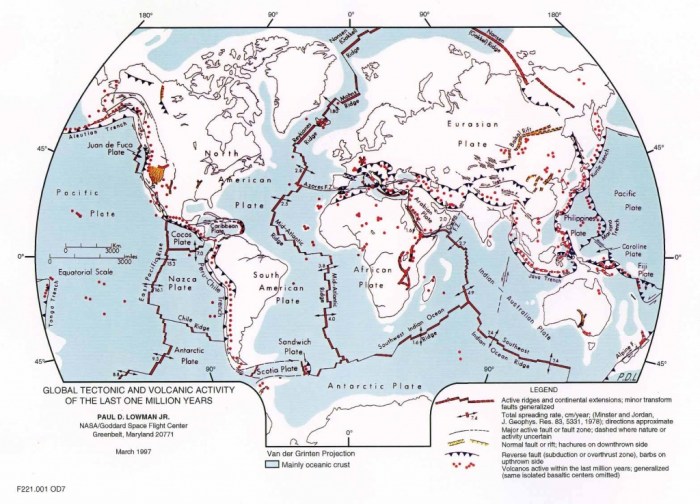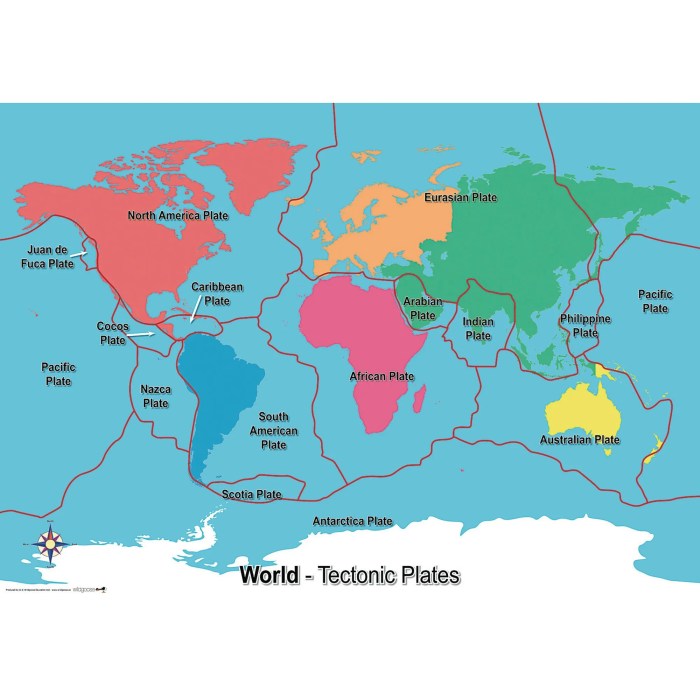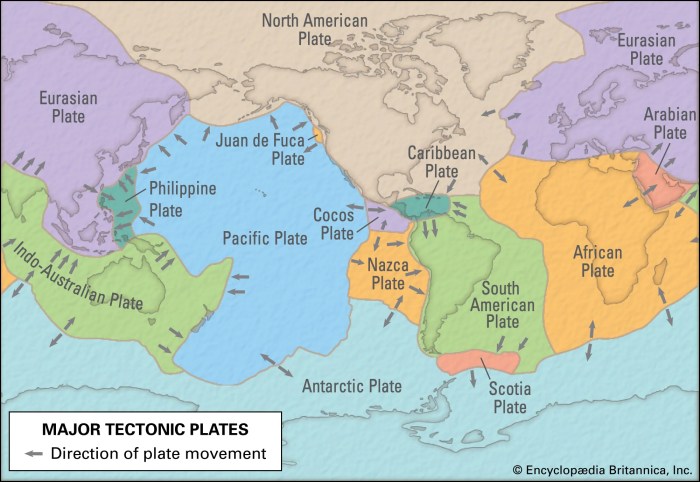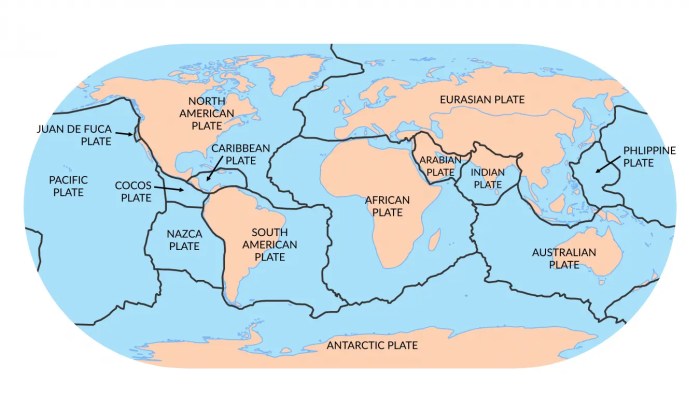Tectonic plates map new york – Embark on a journey into the depths of New York’s geological tapestry with our comprehensive tectonic plates map. This map unveils the intricate dance of tectonic plates that has sculpted the state’s diverse landscapes, from towering mountains to verdant valleys.
Our map meticulously charts the boundaries between these colossal plates, revealing their profound impact on New York’s geological evolution. Delve into the fascinating stories behind the formation of mountains, valleys, and other geological wonders.
Tectonic Plate Boundaries in New York

New York State lies within the North American Plate and is not directly affected by any major tectonic plate boundaries. However, the state does experience minor seismic activity due to the presence of several fault lines and the influence of distant plate boundaries.
The closest major tectonic plate boundary to New York is the Mid-Atlantic Ridge, which is a divergent plate boundary located in the Atlantic Ocean. This boundary is where the North American Plate and the Eurasian Plate are moving away from each other.
Types of Plate Boundaries in New York
Despite not having any major plate boundaries within its borders, New York State does have several minor fault lines that are associated with different types of plate boundaries. These fault lines are mostly inactive, but they can still produce earthquakes.
| Boundary Type | Location | Description |
|---|---|---|
| Divergent Boundary | Mid-Atlantic Ridge (offshore) | The North American Plate and the Eurasian Plate are moving away from each other. |
| Transform Boundary | Ramapo Fault | The North American Plate and the Eurasian Plate are sliding past each other. |
| Convergent Boundary | None | No convergent plate boundaries are present in New York State. |
Impact of Tectonic Plates on New York’s Geology

Tectonic plates have played a pivotal role in shaping the geological features of New York. The collision and interaction of these plates have resulted in the formation of mountains, valleys, and other geological structures. Additionally, plate tectonics has influenced the distribution of minerals and natural resources within the state.
The tectonic plates map of New York is a fascinating look at the geological history of the region. It shows how the plates have shifted and collided over time, creating the unique landscape we see today. For those interested in learning more about the cultural impact of tectonic plates, ying ying the joy luck club is a great read.
This novel explores the lives of four Chinese immigrant women and their families as they navigate the challenges of living in America. The novel’s exploration of identity and culture is a powerful reminder of the human impact of tectonic plates and the ways in which they shape our lives.
Formation of Mountains and Valleys
The collision of the North American and African plates during the Alleghenian orogeny, which occurred approximately 300 million years ago, led to the formation of the Appalachian Mountains. These mountains were formed as the African plate subducted beneath the North American plate, causing the crust to fold and uplift.
The subsequent erosion of these mountains has created the valleys and gorges that are now found in the region.
Distribution of Minerals and Natural Resources
Plate tectonics has also influenced the distribution of minerals and natural resources in New York. The Adirondack Mountains, located in the northeastern part of the state, are home to a variety of minerals, including iron ore, titanium, and zinc. These minerals were formed as a result of the subduction of the Iapetus Ocean during the Taconic orogeny, which occurred approximately 450 million years ago.
The subsequent uplift and erosion of these mountains has exposed these minerals, making them accessible for mining.
Historical and Future Tectonic Activity in New York: Tectonic Plates Map New York

New York has a rich geological history shaped by tectonic activity. Understanding past events and assessing the potential for future activity is crucial for disaster preparedness and sustainable land use planning.
Past Tectonic Events
New York has experienced several tectonic events throughout its geological history. The most significant was the Taconic orogeny, a mountain-building event that occurred about 450 million years ago. This event resulted from the collision of the North American and African plates, causing the formation of the Taconic Mountains in eastern New York.
Other notable tectonic events include the Acadian orogeny (about 375 million years ago) and the Alleghanian orogeny (about 300 million years ago). These events further shaped the geology of New York, contributing to the formation of the Appalachian Mountains.
Seismic Activity
New York is located in a region with relatively low seismic activity. However, several earthquakes have been recorded in the state, including the 1944 Massena earthquake (magnitude 5.8) and the 2002 West Seneca earthquake (magnitude 4.2).
While major earthquakes are rare in New York, the potential for seismic activity exists. The state is crossed by several fault lines, including the Ramapo Fault and the Clarendon-Linden Fault. These faults have the potential to generate earthquakes in the future.
Volcanic Eruptions
There are no active volcanoes in New York. However, the state has experienced volcanic activity in the past. The Palisades Sill, a large igneous intrusion, formed about 200 million years ago during the Triassic period. This intrusion created the distinctive cliffs along the Hudson River.
Potential for Future Tectonic Activity
The potential for future tectonic activity in New York is difficult to predict with certainty. However, based on the geological history of the region, it is possible that earthquakes or other tectonic events could occur in the future.
Understanding the potential for future tectonic activity is important for disaster preparedness and land use planning. By taking appropriate measures, New York can mitigate the risks associated with tectonic events and ensure the safety of its residents.
Importance of Understanding Tectonic Plates for New York

Comprehending tectonic plate movements is paramount for stakeholders in New York City. This knowledge aids in informed decision-making regarding land use, hazard mitigation, and resource management. Moreover, it influences public policy and shapes urban planning strategies.
Land-Use Planning
Understanding tectonic plates helps identify areas prone to seismic activity and other geological hazards. This information guides land-use planning, ensuring that critical infrastructure, residential areas, and economic centers are not situated in high-risk zones. By considering tectonic plate movements, planners can mitigate the potential impacts of earthquakes, tsunamis, and other natural disasters.
Hazard Mitigation
Knowledge of tectonic plate boundaries allows for the development of effective hazard mitigation strategies. Scientists can assess the likelihood and magnitude of future seismic events, enabling the implementation of building codes, early warning systems, and emergency response plans. By understanding the underlying geological processes, communities can prepare for and minimize the impact of tectonic activity.
Resource Management, Tectonic plates map new york
Tectonic plates play a crucial role in the formation and distribution of natural resources. By studying plate boundaries, geologists can identify potential mineral deposits, hydrocarbon reservoirs, and geothermal energy sources. This knowledge supports sustainable resource management practices, ensuring the availability of essential resources for the city’s future.
Public Policy and Decision-Making
Research on tectonic plates informs public policy and decision-making processes. Policymakers rely on scientific data to develop regulations and allocate resources for disaster preparedness, infrastructure development, and environmental protection. Understanding tectonic activity helps shape urban planning policies, building codes, and emergency management strategies, ensuring the safety and well-being of New York City’s residents.
General Inquiries
What are the major tectonic plates that interact with New York?
The North American Plate and the Eurasian Plate
How have tectonic plates influenced the formation of New York’s mountains?
The collision of the North American and Eurasian plates created the Appalachian Mountains.
What is the significance of understanding tectonic plates for New York’s infrastructure?
It helps identify areas at risk of earthquakes and other geological hazards.

